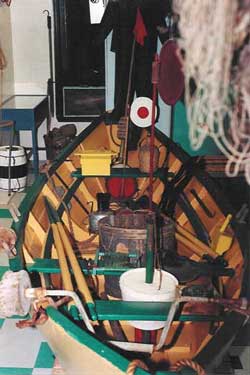The collections: Displays featuring recovered artifacts from 18th-century sunken ships (e.g., Le Chameau and The Feversham). Model ships. Many artifacts (c. 1850-1950) pertaining to the local history of the North Atlantic fisheries on the Grand Banks, including a dory, with complete fishing gear. Display on swordfishing. Lenses from the Louisbourg Lighthouse. Aquarium (a 300-gallon tank) with various saltwater marine species. Also, many fish specimens, preserved in acrylic: dogfish, codfish, haddock, monkfish, skate, turbot, and others; and a giant leather-back turtle.
The present collection essentially stems from that of Alex Storm, the famous diver and adventurer who discovered Le Chameau and other sunken treasures. Many of these artifacts were originally shown at his Atlantic Statiquarium Marine Museum (1960s - late 1980s) in Louisbourg.
Below:
This is a reproduction by Alex Storm of the layout at the bottom of the sea when Le Chameau was discovered.
Clay pots and dishes, shaving bowl, coins, lead balls (grape shot), 2 and 3-pound cannon balls.
 Le Chameau: a 44-gun, 600-ton, French man-of-war, the pride of the French navy, "one of the fastest and best equipped line-of-battle ships in the royal navy of France".
On August 27th, 1725, in a storm off Cape Breton, while trying to make the mouth of Louisbourg harbour, Le Chameau was swept in upon the rocky shore. Every soul aboard was lost. Much of the wreck was washed ashore and was picked up by those sent from Louisbourg. Cast up from the sea were 180 bodies. A burial, en masse, was carried out with the missionary priest at Baleine officiating.
There was no sign of the after part of the ship having come ashore, so it was hoped that some salvage might be made of her guns and treasure, particularly as the rock on which she broke up was covered at low tide by only a few feet of water. The next season some soldiers who were skilled divers were sent from Quebec and employed at the wreck. The treasure, however, was not located at the time.
It is interesting to note that Le Chameau went down in a storm in 1725, that the first person to attempt salvage in 1726 was named Tempete, or "Storm", and that she was "raised" by Alex Storm in 1965, more than two centuries later.
Over 2000 coins were recovered from Le Chameau. This French pay vessel sank before it could pay its workers in the New World.
(Excerpts from various Web sites) READING:
Alex Storm, "Seaweed and Gold: The Discovery of the Ill-Fated Chameau, 1961-1971", in: The Island, New Perspectives on Cape Breton History 1713-1990. Kenneth Donovan, Editor. UCCB Press, 1990. In 1711, the English ship H.M.S. Feversham requisitioned £569 12s5d in money from the British Treasury Office in New York City, before setting sail for Quebec City. She was to escort vessels with food supplies for the Royal Navy warships and to assist the British fleet for an attack on Quebec.
On its way north, the ship sank off Cape Breton.
In 1984 she was found and salvaged.
It is believed the coins on board were likely the unspent balance after purchasing provisions. The entire corpus of material, mainly Spanish American silver cobs and Massachusetts Bay Colony shillings, not a large salvage by comparison with the cargoes of Spanish treasure ships, was auctioned by Christie's in New York, 1989. Some Web sites about Le Chameau and
The Feversham: 
A 'Grand Bank dory', built in Louisbourg, completely outfitted for 2 men. The dory would be dropped off the side of a schooner. Fishing period: from the 1850s to the 1950s.
Items presented: high flyer, trawl tub, girdie, side hawler, basket-weave water cask, hand-line and jig, gaffs, kerosene signal lantern, bailer, south'wester. Dory horn (not visible). More interesting Web sites: Some Web sites about Louisbourg: The Louisbourg Marine Museum is on the Fleur-de-lis Trail.
How to get there (from Sydney and Glace Bay):
|